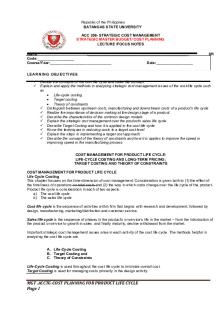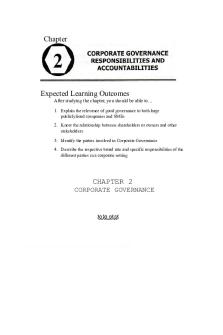Chapter 22 - Lecture notes 22 PDF

| Title | Chapter 22 - Lecture notes 22 |
|---|---|
| Author | Isabelle Engelberg |
| Course | Organic Chemistry II |
| Institution | Johns Hopkins University |
| Pages | 4 |
| File Size | 234.9 KB |
| File Type | |
| Total Downloads | 66 |
| Total Views | 196 |
Summary
Falzone...
Description
Isabelle Engelberg Falzone Organic Chemistry II Chapter 22 Amino Acids, Peptides and Proteins GOALS 1. You should know the different types of amino acid side chains (acidic, basic, hydrophobic, polar); 2. The pI of an amino acid is and how to determine it 3. That 19/20 of the L‐ amino acids are chiral and that all but cysteine are in the S‐ configuration; Ile and Thr have chiral side chains 4. Primary, secondary, tertiary, and quaternary structure and how to recognize α helices and β‐ sheets (parallel and anti‐ parallel); post‐ translational modifications; disulfide bonds 5. Dihedral angles; allowed dihedral angles—Ramachandran plots indicate allow bond angles based on steric interactions. 1. TYPES OF SIDE CHAINS - side chain = other side of NH3 Acidic Asp (D) Glu (E) Basic Lys (K) Arg (R) – most basic His (H) Nonpolar (Hydrophobic) Gly (G) Ala (A) Val (V) Leu (L) Ile (I) Met (M) Pro (P) Phe (F) Trp (W) Polar Asn (N) Gln (Q) Ser (S) Thr (T) Tyr (Y) Cys (C)
2. pI OF AMINO ACIDS pI = pH at which there is no net charge
o positive charge exactly balances negative charge for neutral amino acids, pI = average of pKaNH3+ and pKaCOOH o does not have an ionizable side chain for amino acids that have an ionizable side chain, pI = avg of pKas of similarly ionizing groups for basic side chains, pI = average of 2 highest pKas (2 positively charged) for acidic side chains, pI = average of 2 negatively charged pKas o pKa values lower than the –NH3+ group to have no net charge, we need to be halfway btw the 2 acidic or basic groups to get one negative or positive charge to balance the existing positive (amino) or negative (carboxylate) charge
3. CHIRALITY 19/20 L-amino acids are chiral o only glycine is not chiral (2 H’s) o act as enantiomers all in S configuration except cysteine (S is higher priority than O) o use D and L notation o draw amino acid as Fischer projection with carboxyl group at top and R group on bottom o if amino group (NH3+) is on the left = L o most amino acids found in nature are in the L configuration o L = S, D = R o all of the rest side chains have C attached to a C or single bonded O = lower priority than double bonded O Ile and Thr have chiral side chains 4. PRIMARY, SECONDARY, TERTIARY AND QUATERNARY STRUCTURE primary structure = amino acid sequence and location of all disulfide bridges secondary structure = regular conformation adopted by the backbone o α-helix and β-sheet tertiary structure = 3D structure of the entire protein quaternary structure = >1 polypeptide chain, the way the individual polypeptide chains are arranged with respect to one another SECONDARY STRUCTURE describes the repetitive conformations assumed by segments of the backbone chain of a peptide or protein factors that determine secondary structure o regional planarity about each peptide bond (result of partial DB character of amide bond) o minimizing energy by maximizing the number of peptide groups that engage in H bonding (btw the carbonyl O of one amino acid and the amide H of another) o need for adequate separation btw neighboring R groups to avoid steric strain and repulsion of like charges
α-helix: backbone of the polypeptide coils around the long axis of the protein molecule o substituents on the α-carbons of the amino acids protrude outward from helix to minimize steric strain o helix is stabilized by H bonds – each amide H is bonded to a carbonyl O 4 amino acids away o right handed due to L-configuration o can be stretched (wool, fibrous protein of muscle) β-pleated sheet: polypeptide backbone is extended in a zigzag structure resembling a series of pleats o H bonding occurs btw neighboring peptide chains o neighboring peptide chains can run in the same direction (parallel) or opposite directions (antiparallel) o substituents must be small in order to be close enough for H bonding o almost fully extended so cannot be stretched (silk, spider webs) DISULFIDE BONDS/POST-TRANSLATIONAL MODIFICATIONS when thiols (R-SH) are oxidized under mild conditions, they form a disulfide bond (S-S) common oxidizing agent is Br2 in a basic solution disulfides can be reduced to thiols cysteine contains a thiol group, so 2 cysteine molecules can be oxidized to a disulfide = cystine 2 cysteines in a protein can be oxidized to a disulfide = disulfide bridge o only covalent bonds that are found btw nonadjacent amino acids in peptides and proteins o contribute to overall shape of a protein by linking cysteines found in different parts of the peptide backbone insulin o insulin is a polypeptide with 2 peptide chains o the chains are connected to each other by 2 interchain disulfide bridges (btw 2 chains) o insulin also has an intrachain disulfide bridge (within a chain)
5. DIHEDRAL ANGLES not all combinations of backbone dihedral angles (φ and ψ) are allowed because of steric clashes Ramachandran plot = the map of allowed pairs (ψ vs. φ) o indicate that 2 types of backbone conformations are acceptable: extended (β-sheet) right-handed helical (α-helix)...
Similar Free PDFs

Chapter 22 - Lecture notes 22
- 4 Pages

Chapter 22 - Lecture notes 22
- 4 Pages

Chapter 8 - Lecture notes 22
- 20 Pages

22 - Lecture notes 1
- 14 Pages

Ch6 22.40.37 22 - Lecture notes 6-22
- 26 Pages

Lecture Notes 1/22
- 2 Pages

Lecture notes 22
- 28 Pages

Chapter 22 Notes
- 12 Pages

282 lecture notes lecture 22
- 93 Pages

Chapter 22 Notes
- 16 Pages

Lecture 22
- 4 Pages

Lecture 22
- 2 Pages

Lecture 22
- 4 Pages

Ch7 22 - Lecture notes 7
- 26 Pages

Sector Model - Lecture notes 22
- 1 Pages
Popular Institutions
- Tinajero National High School - Annex
- Politeknik Caltex Riau
- Yokohama City University
- SGT University
- University of Al-Qadisiyah
- Divine Word College of Vigan
- Techniek College Rotterdam
- Universidade de Santiago
- Universiti Teknologi MARA Cawangan Johor Kampus Pasir Gudang
- Poltekkes Kemenkes Yogyakarta
- Baguio City National High School
- Colegio san marcos
- preparatoria uno
- Centro de Bachillerato Tecnológico Industrial y de Servicios No. 107
- Dalian Maritime University
- Quang Trung Secondary School
- Colegio Tecnológico en Informática
- Corporación Regional de Educación Superior
- Grupo CEDVA
- Dar Al Uloom University
- Centro de Estudios Preuniversitarios de la Universidad Nacional de Ingeniería
- 上智大学
- Aakash International School, Nuna Majara
- San Felipe Neri Catholic School
- Kang Chiao International School - New Taipei City
- Misamis Occidental National High School
- Institución Educativa Escuela Normal Juan Ladrilleros
- Kolehiyo ng Pantukan
- Batanes State College
- Instituto Continental
- Sekolah Menengah Kejuruan Kesehatan Kaltara (Tarakan)
- Colegio de La Inmaculada Concepcion - Cebu
